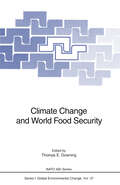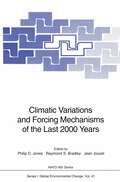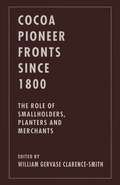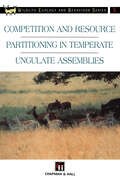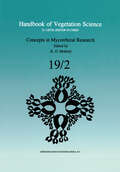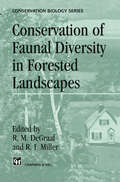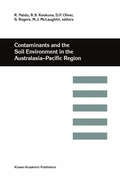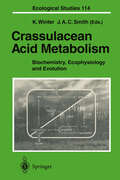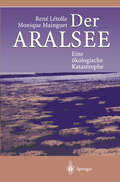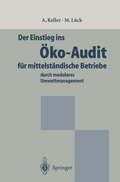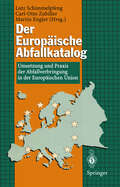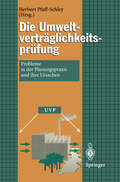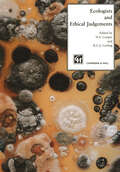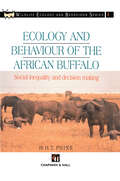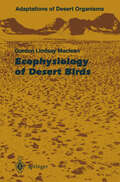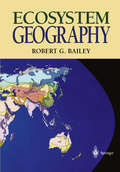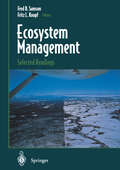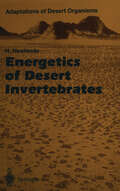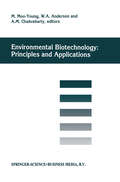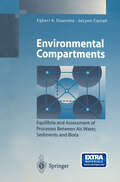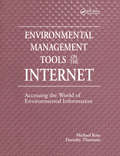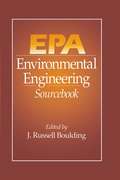- Table View
- List View
Climate Change and World Food Security (Nato ASI Subseries I: #37)
by Thomas E. DowningIn the last half decade since sustainable development became a serious objective, what have we achieved? Are livelihoods more secure? Are nations wealthier and more resilient? Is environmental quality being restored or maintained? These are essential questions of development. Their answers are many, varied between communities and regions, even between individuals. Two years ago, in the aftermath of the Earth Summit and ratification of the Framework Convention on Climate Change, but before the first Conference of Parties, I participated in a panel at the inaugural Oxford Environment Conference on Climate Change and World Food Security. The panel vigorously reviewed issues of resilient development and food security. This book is a product of the Oxford Environment Conference. It takes the essential questions of sustainability as a starting point to focus on present food security and its future prospects in the face of climate change. Why is this book important? First, I believe our goals to end hunger are under threat. We know what to do in many respects, but fail to generate the finances and political will to change the structures that thrive on poverty. Second, I believe concern about the environment has become dangerously separated from the fundamental issues of human deprivation. Third, I believe climate change is a serious threat and I am dismayed at the way nations dither over how to control greenhouse gas emissions and mechanisms to meet the challenge of adverse climate impacts.
Climatic Variations and Forcing Mechanisms of the Last 2000 Years (Nato ASI Subseries I: #41)
by Philip Douglas Jones Raymond Stephen Bradley Jean JouzelA profound knowledge of the past climate is vital for our understanding of global warming. The past 2000 years are both the period which is of most relevance to the next century and that for which there is the most evidence. High-resolution proxy records for this period are available from a variety of sources. Five sections consider dendroclimatology, ice cores, corals, historical records, lake varves, and other indicators. The final two sections cover the histories of various forcing factors and attempt to bring together records from a variety of sources and provide explanations.
Cocoa Pioneer Fronts since 1800: The Role of Smallholders, Planters and Merchants
by William Gervase Clarence-SmithThe livelihood of Third World farmers conflicts with saving the remaining tropical forests. The advantages of growing cocoa in cleared primary forest drive from the fertility of virgin soils and low concentrations of weeds, pests and diseases. The consequent emergence of new 'pioneer fronts' has also been affected by cheap labour, relative commodity prices, pests and diseases, credit resources, entrepreneurship, information, physical infrastructures, and government policies. The dynamism of smallholdings and competitive private marketing over estates and marketing boards is demonstrated.
Competition and Resource Partitioning in Temperate Ungulate Assemblies (Chapman & Hall Wildlife Ecology and Behaviour Series)
by R.J. PutmanRory Putman addresses the question of how, in many temporate ecosystems, diverse and species-rich assemblies of ungulates manage to co-exist despite often quite extensive overlap in ecological requirements. Putman explores the potential for competition, competition tolerance and even positive facilitation amongst the members of such guilds of ungulates. As a central worked example, the author employs data resulting from over 20 years of personal research into the ecology and population dynamics of various large herbivores of the New Forest in Southern England. With these, he applies formal protocols in resource use, evidence for resource limitation and evidence for interaction between species in changing population size over the years.
Concepts in Mycorrhizal Research (Handbook of Vegetation Science #19/2)
by K. G. MukerjiMycorrhiza will be the focus of research and study for the coming decade. Successful survival and maintenance of plant cover is mostly dependent on mycorrhization. During the last decade about ten books have appeared on various aspects of mycorrhiza, including two on methodology. The present book has been compiled to give a complete and comprehensive description of the topic to the students and researchers in botany, applied mycology, biotechnology, forestry and agriculture. The book will also be useful to planners dealing with biofertilizers and forestation. Besides topics of academic interest, the volume includes several aspects which are unique and are written about for the first time, e.g.: Arbuscular Mycorrhizal symbiosis - recognition and specificity; Mycorrhizal Integration and cellular compatibility between Endomycorrhizal symbionts; Cost - economics of existing methodology for inoculum production of vesicular-arbuscular mycorrhizal fungi; Mycorrhiza: Ecological Implications of Plant interactions; Outplanting performance of mycorrhizal inoculated seedlings; Fluorescence microscopy in mycorrhiza studies and Ectomycorrhizal fungi as experimental organism. Other aspects not mentioned above include most recent reviews concerning vesicular-arbuscular mycorrhiza and ectomycorrhizae. The different review chapters have been written by world authorities in their respective specialisations giving more up to date information than is provided anywhere else. This book deals with all major aspects of mycorrhiza, giving structure, ultrastructure, ecology and applications in agriculture and forestry.
Conservation of Faunal Diversity in Forested Landscapes (Conservation Biology #6)
by Richard M. DeGraaf Ronald I. MillerForest wildlife conservation is critically required in many parts of the world today. This book presents a merger between the elements of wildlife conservation and habitat conservation, and explains how these disciplines can be used to promote the conservation of vertebrates in forests around the world.
Contaminants and the Soil Environment in the Australasia-Pacific Region: Proceedings of the First Australasia-Pacific Conference on Contaminants and Soil Environment in the Australasia-Pacific Region, held in Adelaide, Australia, 18–23 February 1996
by R. Naidu R. S. Kookana D. P. Oliver S. Rogers M. J. McLaughlinThe Australasia-Pacific Region supports approximately 50% of the world's population. The last half-century has witnessed a rapid increase in the regional population, agricultural productivity, industrial activities and trade within the region. Both the demand for increased food production and the desire to improve the economic conditions have affected regional environmental quality. This volume presents an overview of the fate of contaminants in the soil environment; current soil management factors used to control contaminant impacts, issues related to sludge and effluent disposals in the soil environment; legal, health and social impacts of contaminated land, remediation approaches and strategies to manage contaminated land, some of the problems associated with environmental degradation in the Australasia-Pacific Region and steps that we need to take to safeguard our environment.
Crassulacean Acid Metabolism: Biochemistry, Ecophysiology and Evolution (Ecological Studies #114)
by Klaus Winter J. Andrew C. SmithCrassulacean acid metabolism (CAM) represents one of the best-studied metabolic examples of an ecological adaptation to environmental stress. Well over 5 % of all vascular plant species engage in this water-conserving photosynthetic pathway. Intensified research activities over the last 10 years have led to major advances in understanding the biology of CAM plants. New areas of research reviewed in detail in this book include regulation of gene expression and the molecular basis of CAM, the ecophysiology of CAM plants from tropical environments, the productivity of agronomically important cacti and agaves, the ecophysiology of CAM in submerged aquatic plants, and the taxonomic diversity and evolutionary origins of CAM.
Der Aralsee: Eine ökologische Katastrophe
by Rene Letolle Monique MainguetDie Besonderheit dieser ersten umfassenden Monographie zur Geschichte und Problematik des Ökosystems 'Aralsee' liegt in deren multidisziplinärer Betrachtungsweise. Die Spannbreite reicht dabei von der Erläuterung der geologischen Entstehung des Aralbeckens über dessen Siedlungs- und Wirtschaftsgeschichte bis hin zur Beschreibung der ökosystemaren Zusammenhänge und deren massive, durch Zivilisation und Ökonomie verursachten Beeinträchtigungen. Neben den Ursachen und Mechanismen, die zu dieser bisher größten durch den Menschen ausgelösten ökologischen Krise führten, gehen die Autoren auch auf die sich daraus ableitbaren Konsequenzen sowie mögliche Gegenmaßnahmen ein.
Der Einstieg ins Öko-Audit für mittelständische Betriebe: durch modulares Umweltmanagement
by Alexander Keller Michael LückDas modulare Umweltmanagement (MUM) ist vor allem für die mittelständische Industrie ein ideales Verfahren zum sukzessiven Aufbau eines betrieblichen Umweltmanagements. In seiner zukunftsweisenden Perspektive kann es stufenweise und überschaubar in ein Umwelt-Audit münden. Das stufenweise Vorgehen ermöglicht dabei eine Adaption an die jeweiligen Gegebenheiten eines Betriebes und erlaubt zudem durch fortwährende Rückübertragung und Kontrolle der Ergebnisse eine ständige Optimierung des Gesamtprozesses.
Der Europäische Abfallkatalog: Umsetzung und Praxis der Abfallverbringung in der Europäischen Union
by Lutz Schimmelpfeng Carl-Otto Zubiller Martin EnglerDie neuen Vorschriften der EU für die Abfallwirtschaft werden in diesem Buch von ausgewiesenen Experten dargestellt, die diese Vorschriften zum Teil miterarbeitet haben. Der umfassende Überblick bietet dem Leser Rechts- und Praxissicherheit beim Umgang mit den neuen Regelungen. Vertreter zweier bedeutender Verbände beleuchten darüberhinaus die Folgen der neuen Vorschriften für die Wirtschaft. Concise text: Ausgewiesene Experten stellen die neuen Vorschriften der EU für die Abfallverbringung vor und beleuchten deren Folgen für die Wirtschaft. Das Buch bietet dem Leser Rechts- und Praxissicherheit beim Umgang mit diesen Vorschriften.
Die Umweltverträglichkeitsprüfung: Probleme in der Planungspraxis und ihre Ursachen
by Herbert Pfaff-SchleyFachleute aus Ingenieurbüros und Verwaltung berichten von Schwierigkeiten, die sich bei der Durchführung einer Umweltverträglichkeitsprüfung (UVP) im Planungsalltag ergeben können. Themen sind u.a. die UVP im Baurecht und in der Bauleitplanung, Gutachten und Gegengutachten, Bewertung, UVP und ÖKO-Audit. Sich ergebende Probleme werden dabei anschaulich anhand konkreter Projekte aus der Praxis erläutert. Concise text: Welche Probleme bei der Durchführung einer Umweltverträglichkeitsprüfung (UVP) im Planungsalltag entstehen können und wie sie zu bewältigen sind, zeigt das Buch anschaulich und praxisorientiert.
Ecologists and Ethical Judgements
by Nigel S. Cooper and R. C. J. CarlingHow we see the world - our attitudes and assumptions about it - profoundly affects the way we deal with it. This book is written by an interdisciplinary team of ecologists, nature conservationists and environmental philosophers. It seeks to make the connection between the theoretical approaches to the valuation of the natural world and how these work in practice.
Ecology and Behaviour of the African Buffalo: Social inequality and decision making (Chapman & Hall Wildlife Ecology and Behaviour Series)
by H.H.T PrinsOver the past 30 years or so, research effort in behaviour and ecology has progressed from simple documentation of the habits or habitats of differ ent species to asking more searching questions about the adaptiveness of the patterns of behaviour observed; moved from documenting simply what occurs, to trying to understand why. Increasingly, studies of behav iour or ecology explore the function of particular responses or patterns of behaviour in individuals or populations - looking for the adaptiveness that has led to the adoption of such patterns either at a proximate level (what environmental circumstances have favoured the adoption of some particular strategy or response from within the animal's repertoire at that specific time) or at an evolutionary level (speculating upon what pres sures have led to the inclusion of a particular pattern of behaviour within the repertoire in the first place). Many common principles have been established - common to a wide diversity of animal groups, yet showing some precise relationship between a given aspect of behaviour or population dynamics and some particular ecological factor. In particular, tremendous advances have been made in understanding the foraging behaviour of animals - and the 'decision rules' by which they seek and select from the various resources on offer - and patterns of social organization and behaviour: the adap tiveness of different social structures, group sizes or reproductive tactics.
Ecophysiology of Desert Birds (Adaptations of Desert Organisms)
by Gordon L. MacleanIn the Preface to his volume on Ecophysiology of the Camelidae and Desert Ruminants in this series, Trevor Wilson mentions his hesitation at the invitation from John Cloudsley-Thompson to write the book, because he had been out of direct touch with desert biology for some years. My response to John's invitation to write Ecophysiology of Desert Birds was much the same, and for the same reasons. However, with his encouragement and, taking account of the fact that a colleague of mine who is much better suited to do the job had turned it down because of pressure of work, I accepted the challenge and have enjoyed it immensely. It has been my privilege to spend much time in the deserts of North and South America, southern Africa and Australia, some of it with my wife, Cherie, whose editing of the entire text has improved the work immeasurably. Indeed, I believe it would have been proper for her to accept coauthorship, but she graciously declined the offer! I owe her a debt of gratitude which I hope will be repaid in part by her seeing the text finally between covers. The chapters on water regulation (Chap. 5) and thermo regulation (Chap. 6) have benefited from the refereeing of my colleague, Dr. Barry Lovegrove, of the Department of Zoology and Entomology, University of Natal, Pietermaritzburg.
Ecosystem Geography
by Robert G. BaileyThe analysis and management of ecosystems rely increasingly on sound geographical knowledge. Ecosystem Geography is a landmark contribution which brings the geographer's tools - maps, scales, boundaries, and units - to the study of ecosystems. The author, a senior geographer and program manager with the U.S. Forest Service, has distilled more than two decades of research on ecosystem mapping and classification. His work has had a growing influence on how government and academic scientists are using ecological data to monitor biodiversity, manage land holdings, and interpret the results of climatic change. Ecosystem Geography features spectacular graphics, including diagrams, photographs, and abundant maps. It will be welcomed by ecologists, geographers, land and resource specialists, and anyone involved in the study of ecosystems.
Energetics of Desert Invertebrates (Adaptations of Desert Organisms)
by Harold HeatwoleDesert invertebrates live in an environment where resources alternate unpredictably between brief periods of plenty and prolonged scarcity. This book describes the adaptive strategies of desert invertebrates in acquiring energy and sustaining life with such fluctuations. Some cooperate in foraging; others compete for resources. Some are nomadic and migrate to more favorable sites as conditions change. Others conserve energy by going into a deep dormancy until better conditions return. Still others store food during plentiful periods so as to retreat underground during less favorable times. The adaptive modes of economizing on scarce energy resources are diverse and lead to an appreciation of the intricate interactions of animals living close to their environmental limits.
Environmental Biotechnology: Principles and Applications
by Murray Moo-Young W. A. Anderson A. M. ChakrabartyBiotechnology offers a `natural' way of addressing environmental problems, ranging from identification of biohazards to bioremediation techniques for industrial, agricultural and municipal effluents and residues. Biotechnology is also a crucial element in the paradigm of `sustainable development'. This collection of 66 papers, by authors from 20 countries spanning 4 continents, addresses many of these issues. The material presented will interest scientists, engineers, and others in industry, government and academia. It incorporates both introductory and advanced aspects of the subject matter, which includes water, air and soil treatment, biosensor and biomonitoring technology, genetic engineering of microorganisms, and policy issues in applying biotechnology to environmental problems. The papers present a variety of aspects ranging from current state-of-the-art research, to examples of applications of these technologies.
Environmental Compartments: Equilibria and Assessment of Processes Between Air, Water, Sediments and Biota (Environmental Science and Engineering)
by Egbert K. Duursma JoLynn CarrollAny concentration of a substance measured in a living or non-living system results from its distribution among all of the environmental compartments: air, water, sediments, and biota. The transfer of a substance from one compartment to another is regulated by physical forces and the chemical properties of the substance and also those of the compartments. When transfer processes are nearly constant in time, a substance will achieve predictable equilibria distributions. It is of utmost importance that students, environmental scientists, and policymakers understand the basic processes which control the distribution of a substance in order to interpret measurements obtained from within a limited number of compartments.
The Environmental Imagination: Thoreau, Nature Writing, and the Formation of American Culture (Wiley-blackwell Manifestos Ser. #4)
by Lawrence BuellWith the environmental crisis comes a crisis of the imagination, a need to find new ways to understand nature and humanity's relation to it. This is the challenge Lawrence Buell takes up in The Environmental Imagination, the most ambitious study to date of how literature represents the natural environment. With Thoreau's Walden as a touchstone, Buell gives us a far-reaching account of environmental perception, the place of nature in the history of western thought, and the consequences for literary scholarship of attempting to imagine a more "ecocentric" way of being. In doing so, he provides a major new understanding of Thoreau's achievement and, at the same time, a profound rethinking of our literary and cultural reflections on nature. The green tradition in American writing commands Buell's special attention, particularly environmental nonfiction from colonial times to the present. In works by writers from Crevecoeur to Wendell Berry, John Muir to Aldo Leopold, Rachel Carson to Leslie Silko, Mary Austin to Edward Abbey, he examines enduring environmental themes such as the dream of relinquishment, the personification of the nonhuman, an attentiveness to environmental cycles, a devotion to place, and a prophetic awareness of possible ecocatastrophe. At the center of this study we find an image of Walden as a quest for greater environmental awareness, an impetus and guide for Buell as he develops a new vision of environmental writing and seeks a new way of conceiving the relation between human imagination and environmental actuality in the age of industrialization. Intricate and challenging in its arguments, yet engagingly and elegantly written, The Environmental Imagination is a major work of scholarship, one that establishes a new basis for reading American nature writing.
Environmental Management Tools on the Internet: Accessing the World of Environmental Information
by Michael KatzThis book provides general information about what is on the Internet and how to access it. It shows how o get environmental information off of the Internet. The book covers the database services that are available on the Internet that charge fees.
Environmental Management Tools on the Internet: Accessing the World of Environmental Information
by Michael KatzThis book provides general information about what is on the Internet and how to access it. It shows how o get environmental information off of the Internet. The book covers the database services that are available on the Internet that charge fees.
EPA Environmental Engineering Sourcebook
by J. Russell BouldingThe U.S. Environmental Protection Agency (U.S. EPA) publishes several series of documents that provide up-to-date information about environmental site assessment and remediation. The EPA Environmental Engineering Sourcebook includes papers and bulletins that focus on remediation of soil and groundwater, making them available in a convenient form.This book compiles thirty-five documents- written by recognized leaders - on major methods and promising new techniques for hazardous waste treatment and site remediation. Each chapter evaluates the type of contaminant and site characteristics needed to select a technology for use at hazardous waste sites.The EPA Environmental Engineering Sourcebook presents EPA documents in an easy-to-use, concise format. It contains numerous graphs, charts and figures that make it an important resource for those involved in environmental protection, site remediation, and site assessment. FeaturesContains chapters written by recognized leadersExamines major methods as well as assesses new techniques for hazardous waste treatment and site remediationPresents information in an easy-to-use, concise formatEvaluates each type of contaminant and site characteristics for selecting technology at hazardous waste sites
EPA Environmental Engineering Sourcebook
by J. Russell BouldingThe U.S. Environmental Protection Agency (U.S. EPA) publishes several series of documents that provide up-to-date information about environmental site assessment and remediation. The EPA Environmental Engineering Sourcebook includes papers and bulletins that focus on remediation of soil and groundwater, making them available in a convenient form.This book compiles thirty-five documents- written by recognized leaders - on major methods and promising new techniques for hazardous waste treatment and site remediation. Each chapter evaluates the type of contaminant and site characteristics needed to select a technology for use at hazardous waste sites.The EPA Environmental Engineering Sourcebook presents EPA documents in an easy-to-use, concise format. It contains numerous graphs, charts and figures that make it an important resource for those involved in environmental protection, site remediation, and site assessment. FeaturesContains chapters written by recognized leadersExamines major methods as well as assesses new techniques for hazardous waste treatment and site remediationPresents information in an easy-to-use, concise formatEvaluates each type of contaminant and site characteristics for selecting technology at hazardous waste sites
